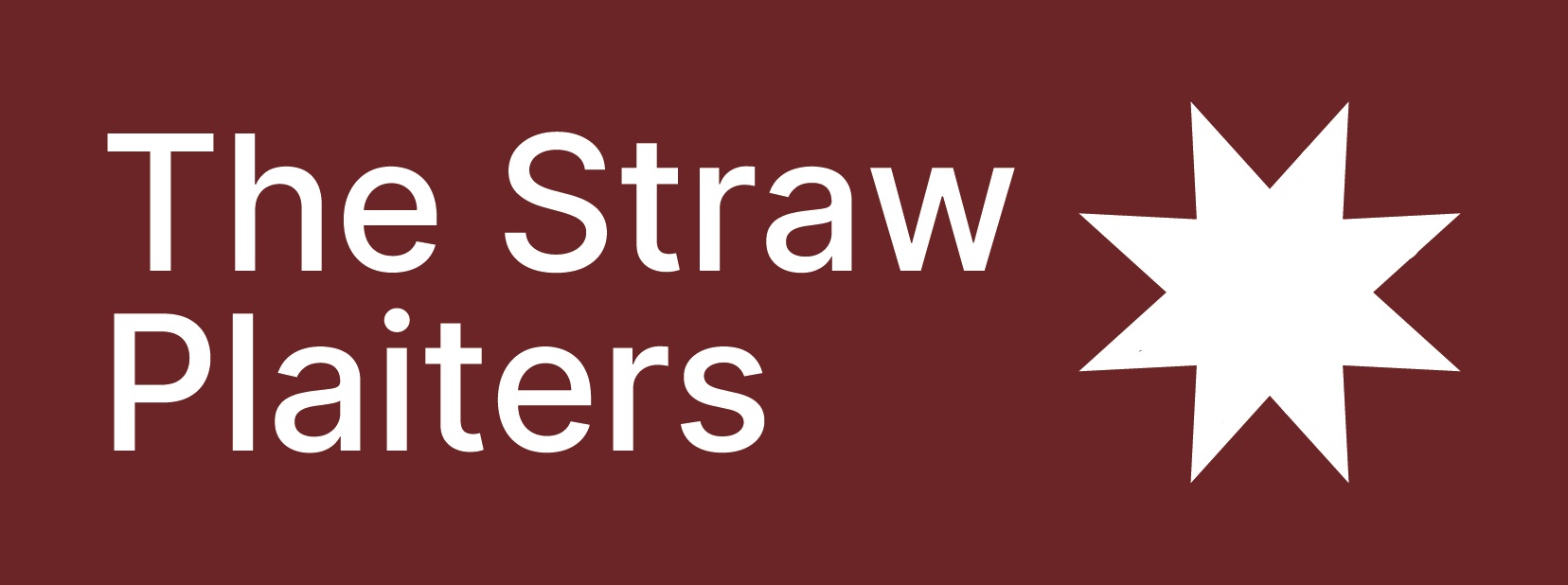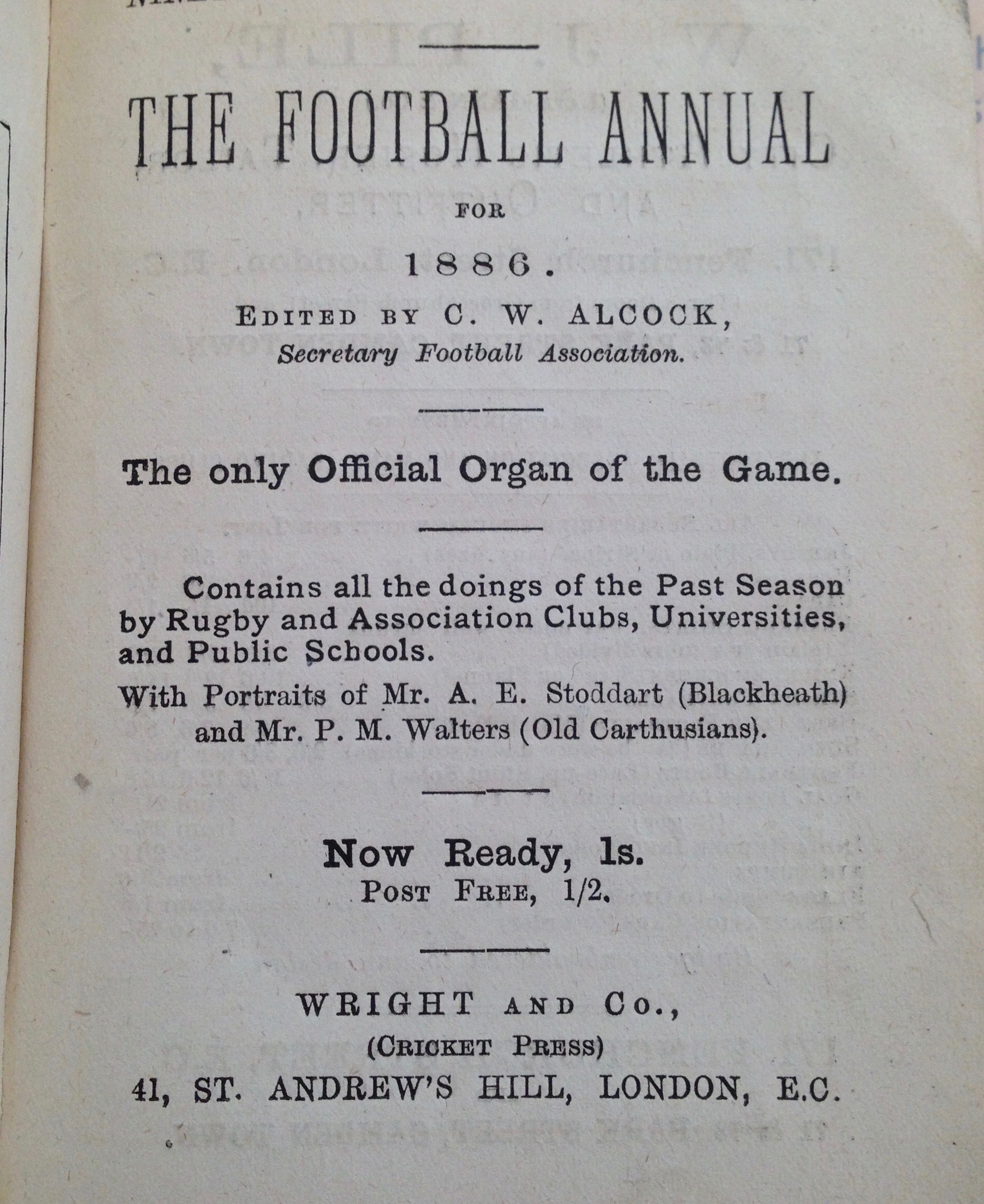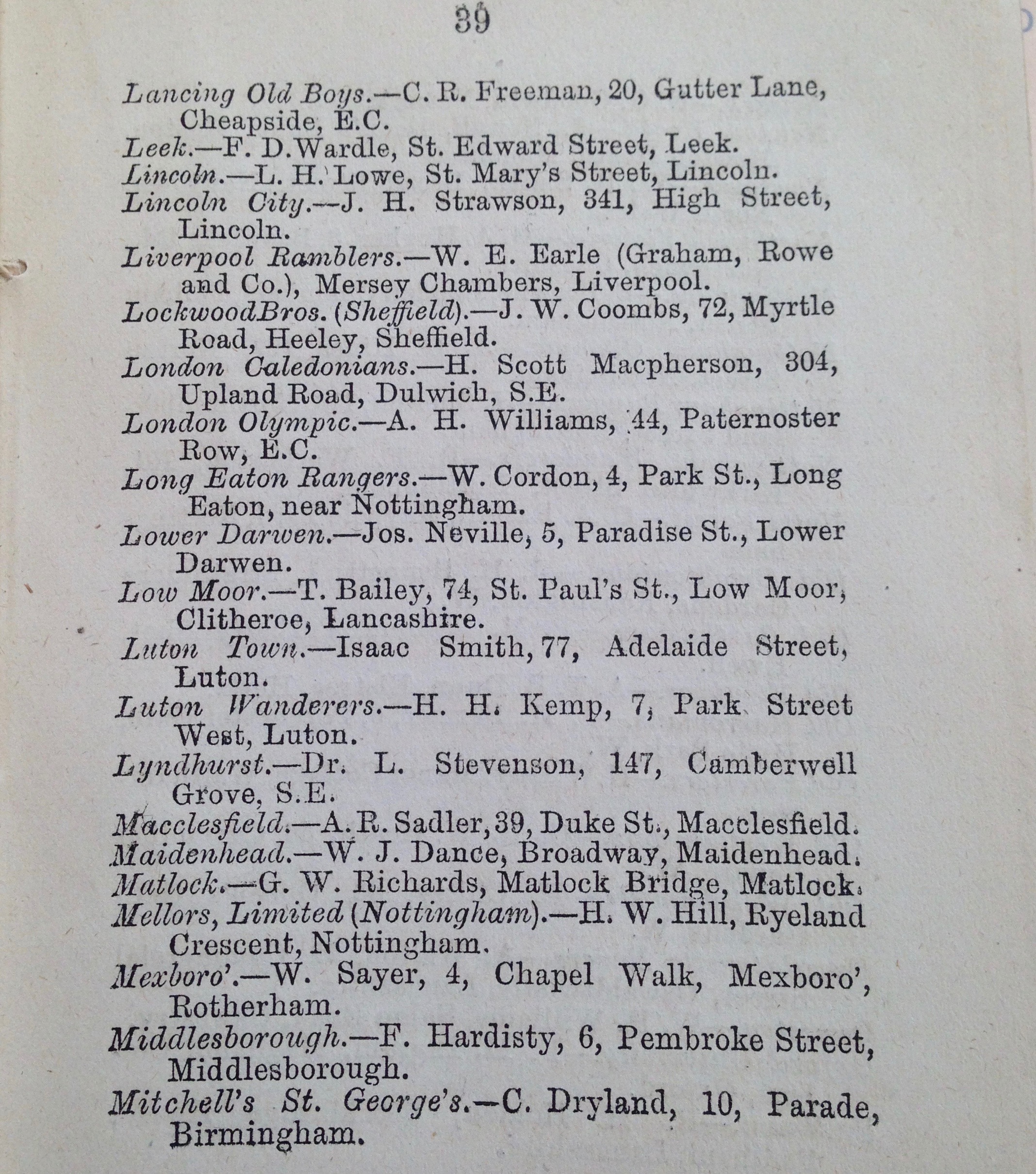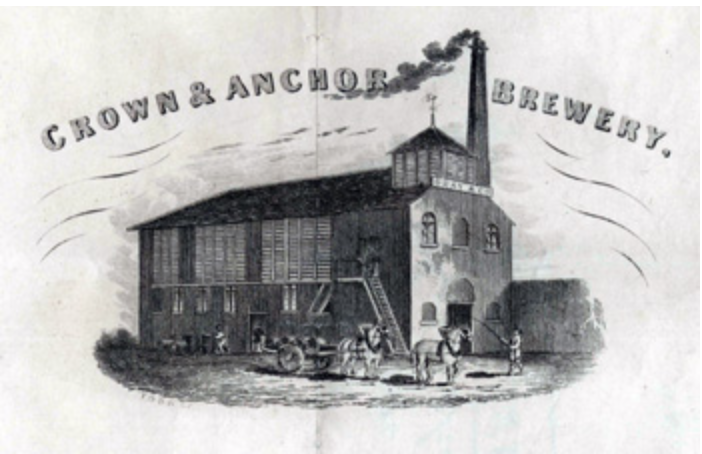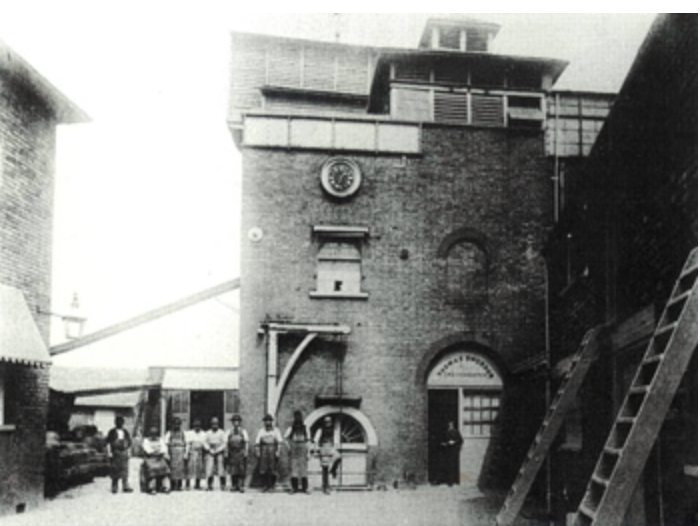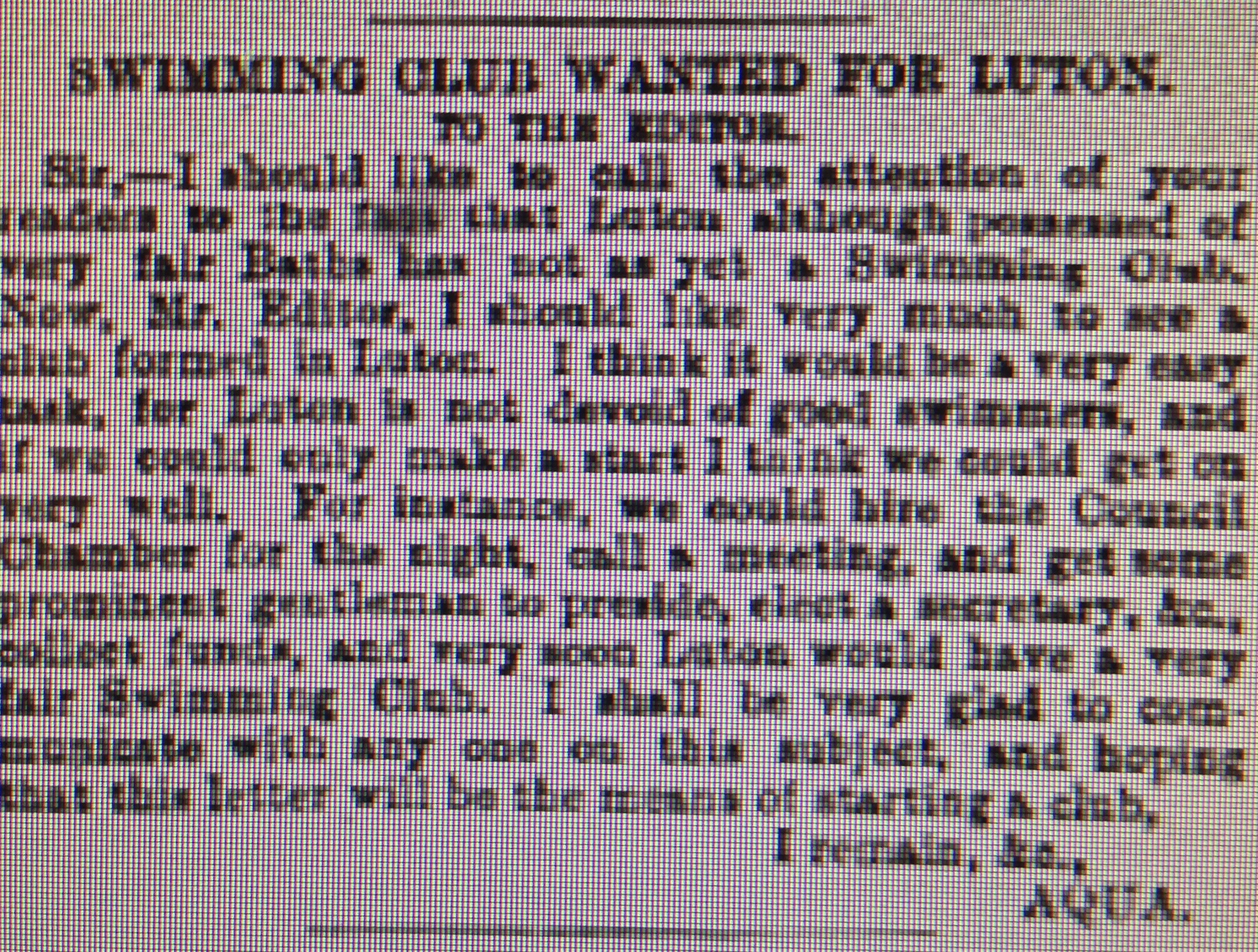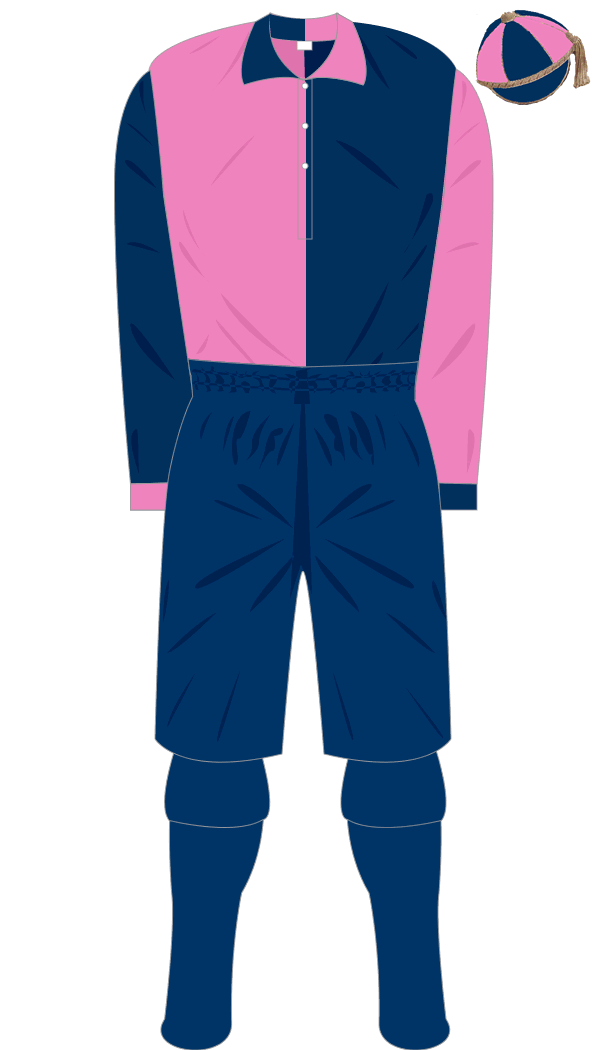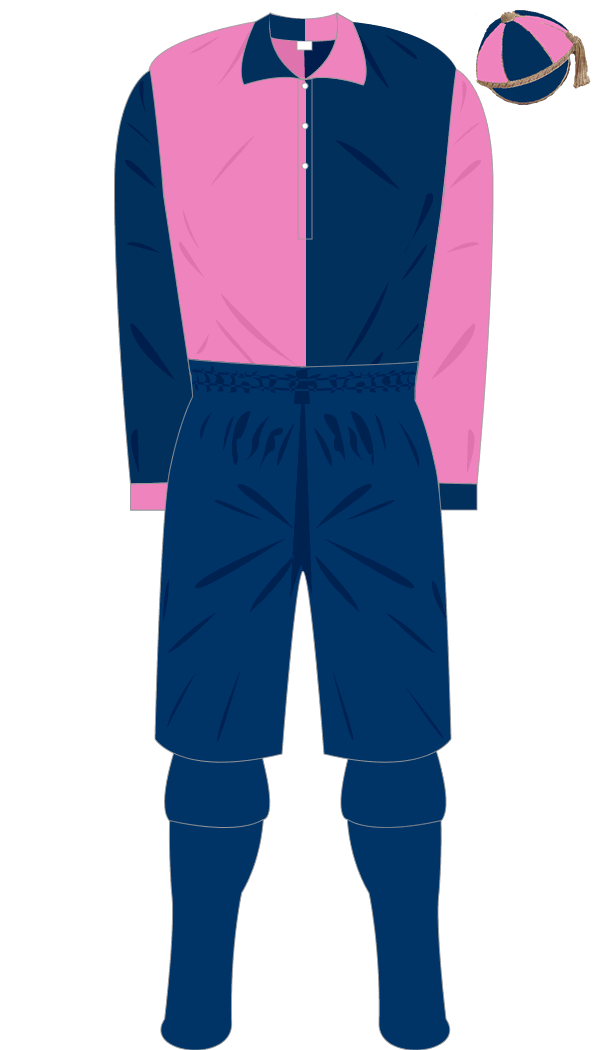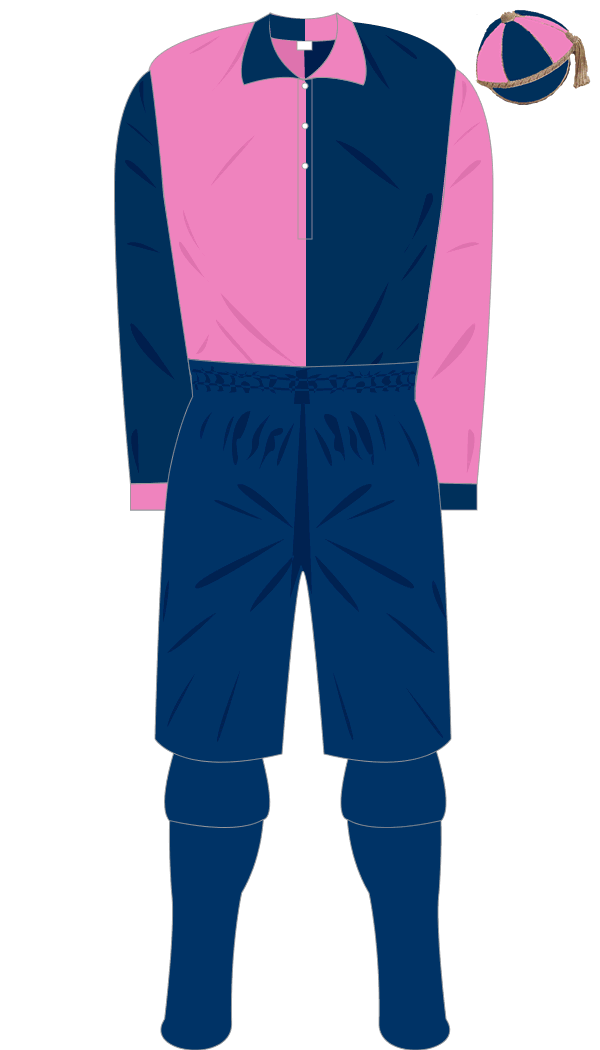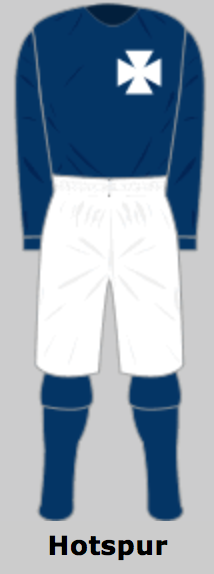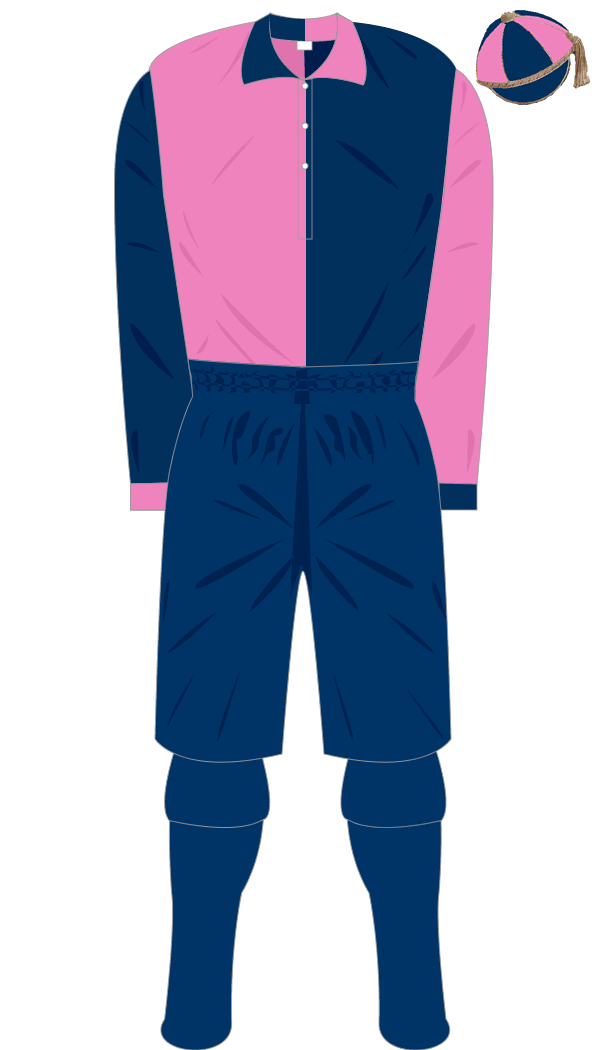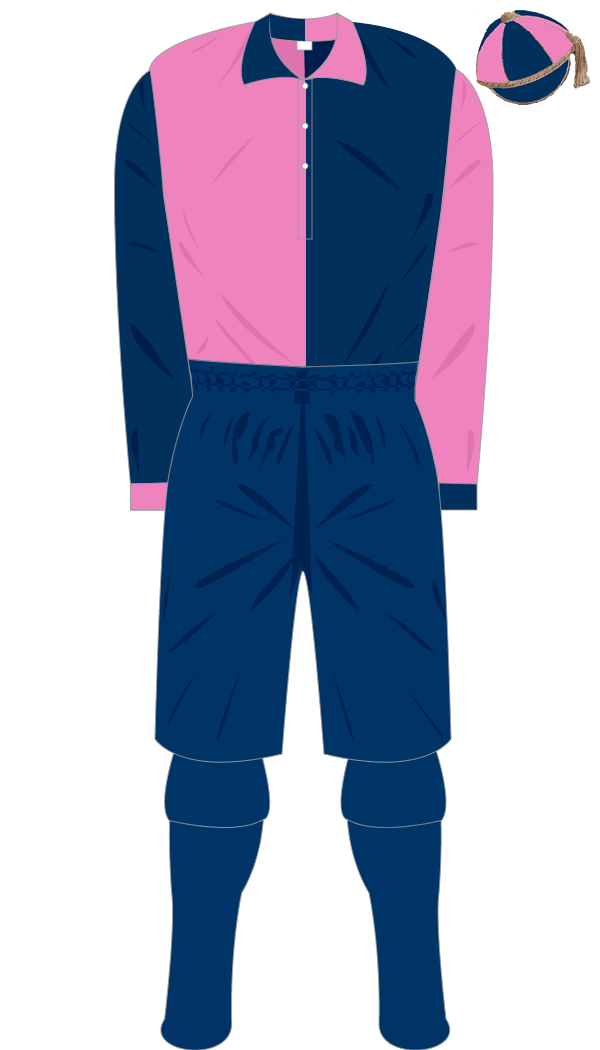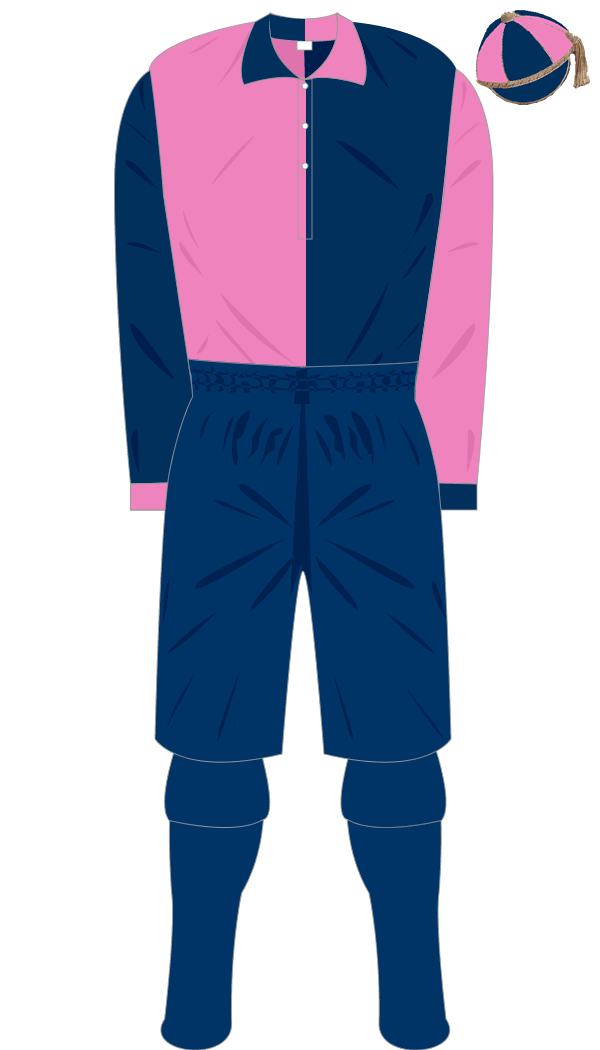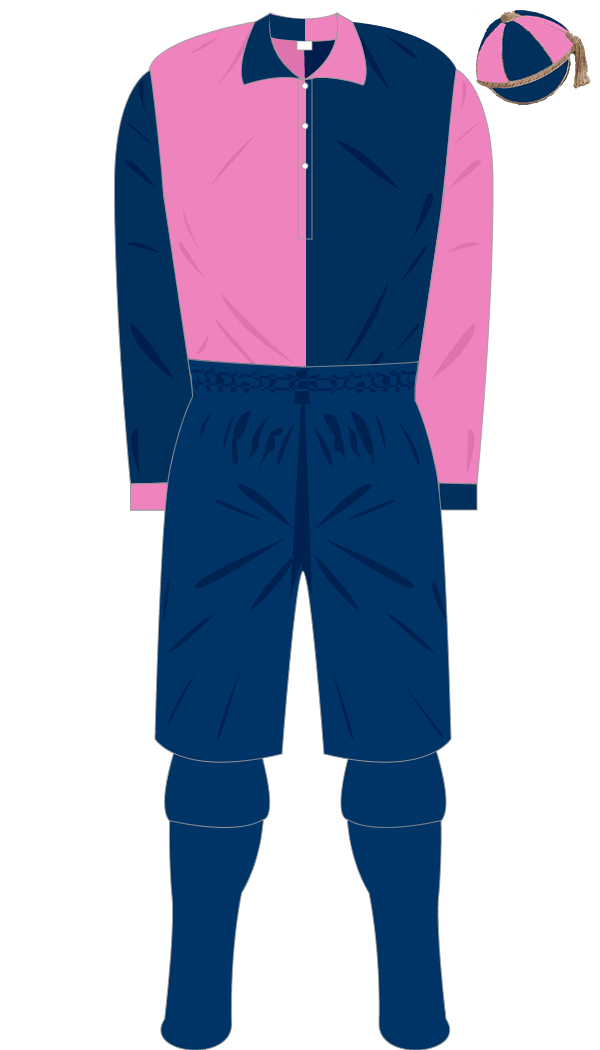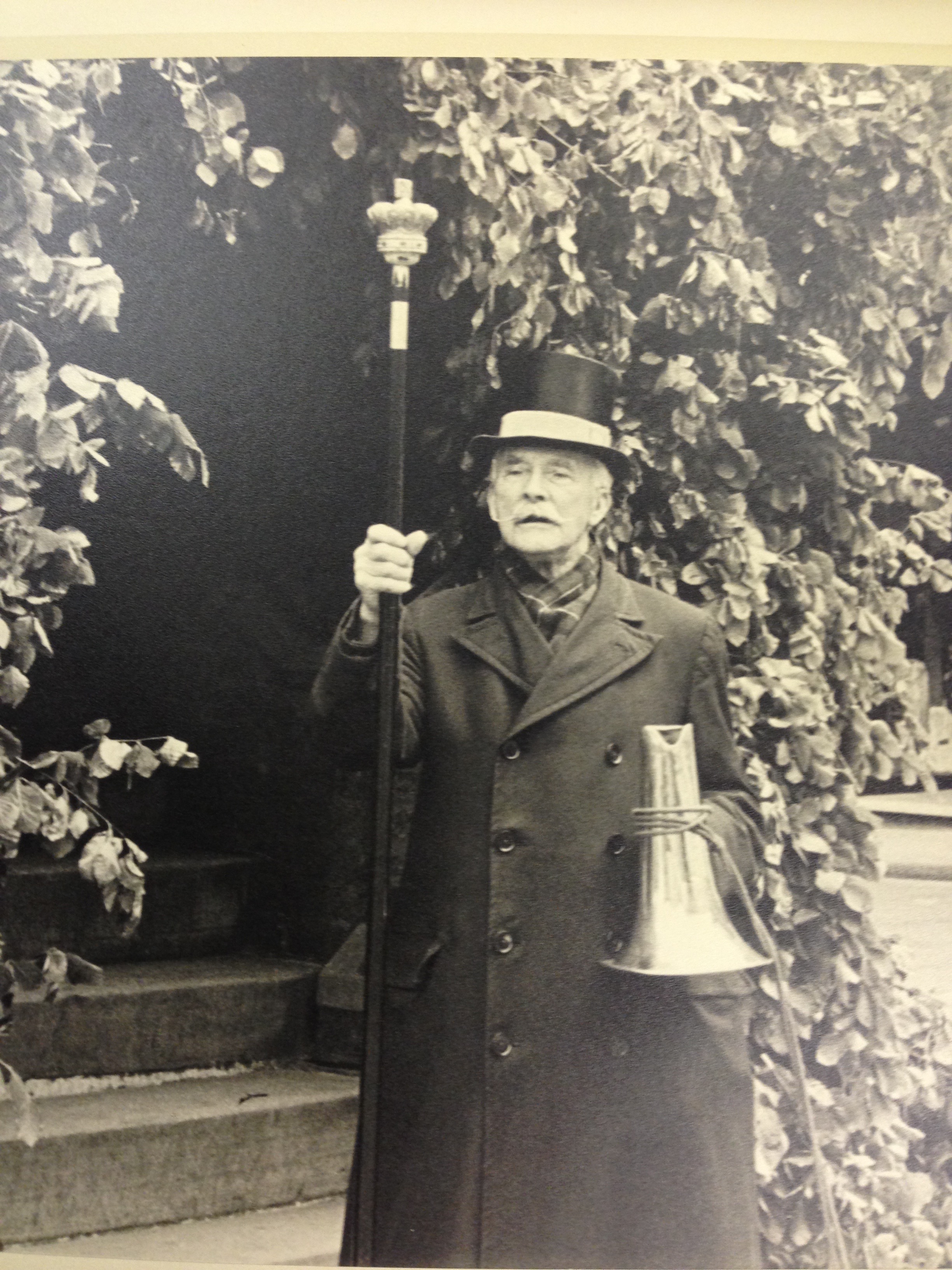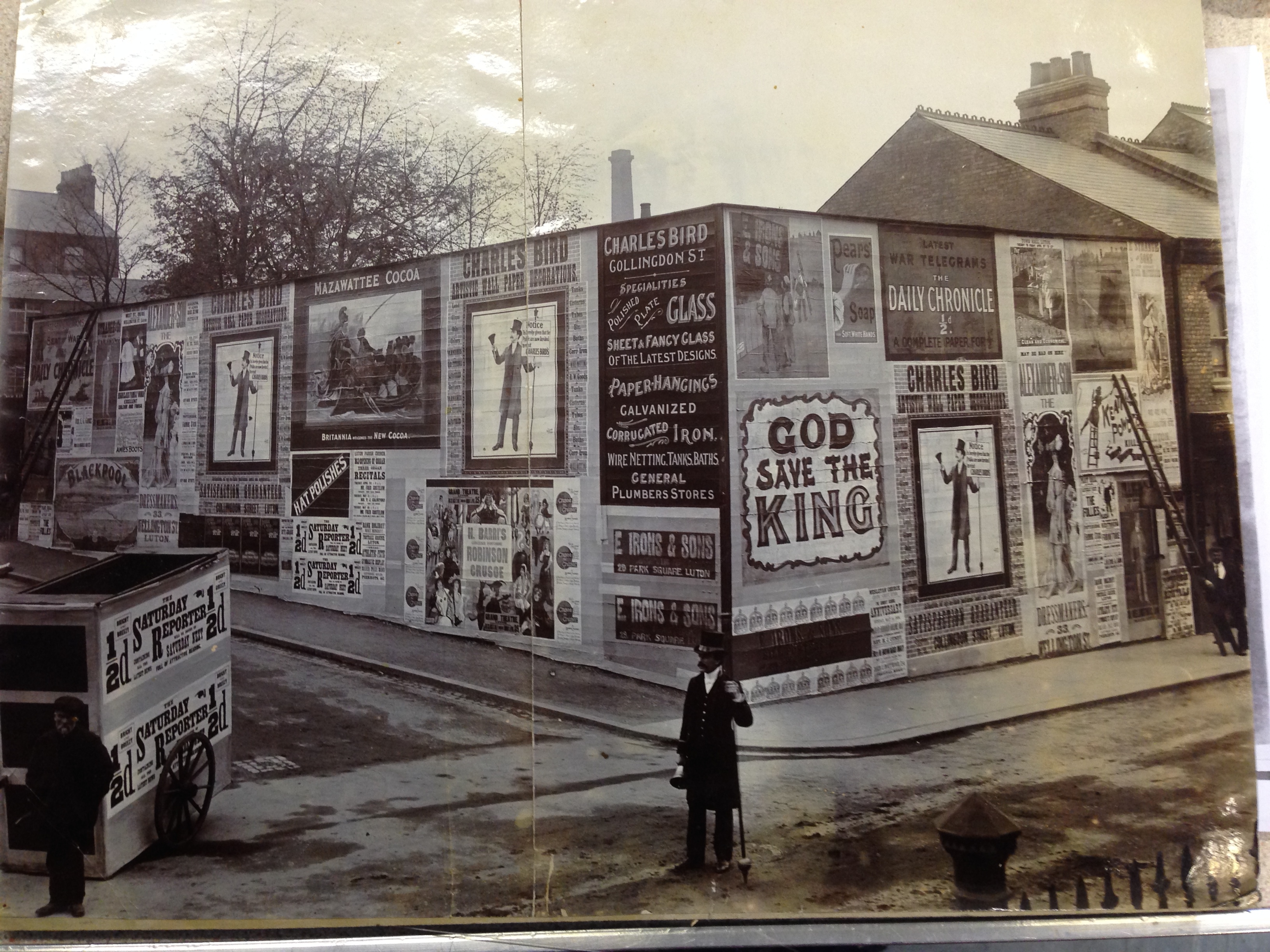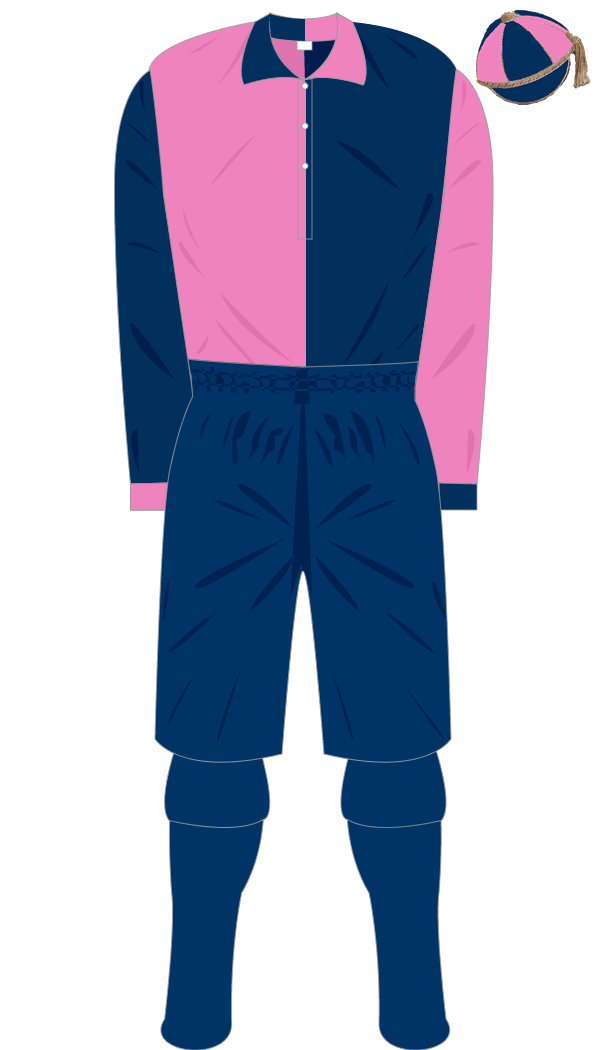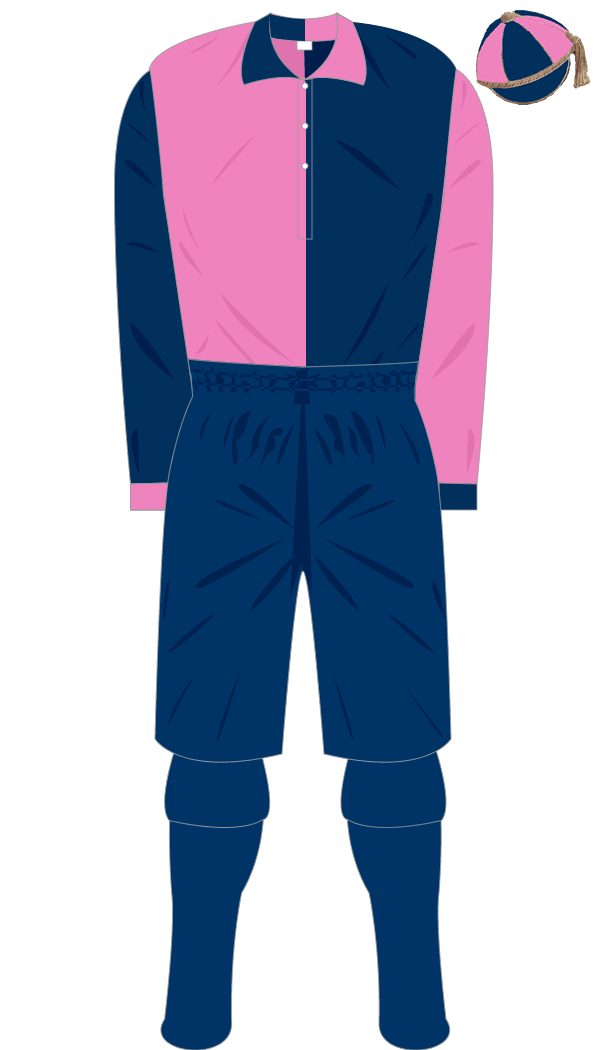CHAPTER TWELVE – AUTUMN FALL, 1886
Page 1 Committee members
Page 3 Luton Town v Dunstable
Page 4 Luton Town v London Scottish and Wellingborough Grammar School
Page 5 Luton Town v Luton Albany
Page 6 Luton Town v Watford Rovers
Page 7 Luton Town v Hotspur, F.A. Cup first round
Page 8 Luton Town v St. Albans, Bedford and Olympians
Page 9 Luton Wanderers self destruct
Page 10 The weather intervenes
After the excitement of the first season one wonders what the expectations of the players, committee and fans were for the second season. They had made a profit in the first season in spite of the appalling weather cancelling 20 games. The club has tried out 55 different players but failed to get past the first hurdle in the F.A. Cup away to Marlow. The F.A. Cup was again the only competition the club entered in their second season. There were rumours that J.C. Lomax had agreed to play for St. Albans. Mr Long had asked him about the rumours and was assured that Luton would have first call on his services. J.C. Lomax did, though, turn out for St. Albans the week before the Straw Plaiters’ first game. However, after that, for the time being he kept his word and chose to play for Luton before any other team.
The Football Annual contained all the information an Association Football and Rugby Football team required. Within were the F.A. Rules, the Laws of the game with clarifications for referees and umpires and the rules of the F.A. Cup. It also gave some useful club contact details. It was edited by the legendary C.W. Alcock, the Secretary of the Football Association.
The committee met on 14th September 1886 at the Alexandra Coffee Tavern. Of the new committee please look under the biography button for George Deacon, James Henry Bennett and Frank Pitkin. There is a already a profile of Herbert Spratley and John Long in Chapter Six. I have had no luck in tracing F. Saunders. Of the other new committee members, there is little detail aside from Ancestry website information.
Charles Brown. The family was a large one and I have not been able to pin him down at the moment. I do have a photo of a Charles Brown, a cricketer, but I have not been able to clarify whether he is the committee member. It probably is him, but I will err on the side of caution at the moment in the hope that new information will come to light.
Frederick Scott was born in Luton in 1858. In 1881 he was a Block Maker living at 1 Alma Street with his mother and father. By 1891 he was still a block maker but married to Henrietta and living at 3 Collingdon Street. He died in Luton on the 20th August 1932 leaving £1,074 11s 10d to his wife and two sons.
Edward Ellingham was born in Luton on the 24th May 1864. In 1881 he was living with his Mum and Dad at 36 John Street and was a Straw Hat Blocker. He joined the Railway Police in 1890 and by 1891 was living in Wealdstone. The 1891 census shows him boarding at a Guest House and describes him as a Railway Official. He died on the 18th May 1843 in Watford.
Henry Wilkins was born in Luton in 1857. In 1881 he was a Blocker living with his wife, Maria, at 11 Old Bedford Road. By 1891 he was a Engineer driller and Maria a Straw Hat sewer living at 15 Old Bedford Road with their 5 daughters, one son, his mother and brother, who was a widower, plus a boarder.
Frederick William Hill was born in Luton on the 15th April 1865. He was baptised on the 1st April 1866 at the Wesleyan Chapel, Luton. In 1881 he was living with his Mum and Dad at 28 Wellington Street and was employed as a Clerk for the Midland Railway. Ten years later he was a boarder at the Cowpers Arms, 53 Cheapside and was a Straw Hat Warehouseman. Frederick died in Luton in 1935.
Arthur D Almond was born in 1862 in Hounslow. In 1881 he lived in Cheapside and was a Tinman’s apprentice to his father. By 1901 he lived at 51 Cheapside and was a Tinsmith. He died in 1916 in Luton.
Finally, there was George Hinson who was born on the 16th June 1862 in Luton. His father was a Blocker and his Mother a Hat Sewer and both came from Chalgrave. George was baptised on the 20th August 1862 at the Wesleyan Chapel, Luton. In 1881 he was a draper living with his parents at 46/48 Wellington Street. He married Annie Horn in 1888. The 1891 Census shows them living at “Southview” in Crawley Road with George employed as a Straw Hat Warehouseman.
————————————-
Page 2
George Deacon chaired the meeting and Mr Pitkin gave a report about the hiring of the meadow for the season. Frank Pitkin was of course on the committee of both Luton Town and Wanderers at this time. It appears that he was good at what he did as neither club objected to this. Again the season seems to have begun with a crisis as it was not clear that the club would be able to use the Dallow Lane Meadow. Mr Long entered the meeting late to say that the matter had been successfully negotiated.
Another minor crisis arose when it was revealed that Mr Howkins of the Fox Inn said it was impossible for him to provide a dressing room for the players. Frank Pitkin came to the rescue stating that he had been talking to Mr Stackhouse of the Crown and Anchor and that he had an extra large room which he could divide into two, provide teams with towels and water free. It was thought to be a generous offer and therefore it was carried unanimously that Mr Pitkin inform Mr Stackhouse that his kind offer be accepted. The Crown and Anchor (below in 1849) was on the corner of Old Bedford Road and Bridge Street. Thomas Sworder had his brewery there which extended along Bridge Street to the river. Sworder sold out to his rival, J.W. Green in 1897.
The committee also considered a letter from the Secretary of Hotspur concerning the date of the English Challenge Cup tie. Two delegates were chosen to send to an E.M.C.F.A. meeting which proposed to amalgamate with the Northampton and District Association.
Finally, the committee resolved that a urinal be fixed by Mr Almond at the cheapest possible rate, the second structure to be erected on the Dallow lane ground. It was also agreed that clubs cards be purchased from Mr King and two number 4 balls be purchased. Today a number 4 ball is used by children aged 9 to 11. The 1885 Laws of the game stated that the ball to be used in matches had to be between 27 and 28 inches in circumference – a number 5 ball, which is still used today.
————————————-
Page 3
The next meeting reports that the dressing room at the Crown and Anchor was secure, the E.M.C.F.A. amalgamated with Northants and District and that Mr Pitkin stated he had come to terms with Mr Saunders respecting the meadow and had paid 5 guineas for the season.
The committee also dealt with a letter from Notts Swifts stating that they had dates on December 27th and Easter Monday and would be pleased to arrange matches on the half gate or expenses system. It was therefore resolved that the Easter Monday be accepted on the half gate system. This meant that Luton Town’s expenses would be taken from the gate receipts and the remainder split between the two clubs. It was a gamble by the away side that half the receipts would cover their own travel and other expenses.
The varied responsibilities of the committee are again highlighted by;
“a rather warm discussion took place with respect to a ground man. At last it was resolved that Mr A. Markin should be ground man, the duties of which should be to attend to ground, roping, and distribute bills, the remuneration for the same to be 3/0 per match (3 shillings)”.
A sub committee was then appointed to inspect the ground consisting of 5 gentlemen, Messrs Deacon, Ellingham, Hinson, Wheeler and Scott.
The committee selected the team to play the first game of the season against Dunstable. Mr J. Bennett was chosen to be umpire and Messrs Almond and Brown, the gatemen. The captain of the team, George Deacon who was to look up the team. You will recall that the annual meeting mentioned that players not turning up had been a problem. The senior player in the team was called upon to instil some discipline.
***
The Luton Reporter of 25th September announced
“the committee of this club have arranged a splendid card of fixtures for the ensuing season. Their first match will be played to-morrow (Saturday) at their own ground, when the Dunstable men will be their opponents”.
“The visitors did not prove nearly such doughty opponents as was anticipated, and the result was an easy victory for the home team by seven goals to nil. Several of the Luton men played exceedingly well, but the same remark scarcely applied to the visitors, for a bit of good play was the exception rather than the rule. The Dunstable men will need to learn to “pass” better and play better together before they can expect to win even a moderately good match. Teams: Luton: Goal, T. Veal; backs, A. Martin and A. Sanders; half-backs, T. Lawrence, H.G. Spratley and T. Read; forwards, G. Deacon, G.H. Small, W. Coleman, W. Miller and W. Wheeler. Dunstable; Goal, A. Davis; backs, E.P. Hughes and W. Bliss; half-backs, L. Warren, W. Currant and J.T. Branson; forwards, W. Hills, J. Gilbey, A. Smart, T.N. Hughes and A. Potton.”
We get an insight into football in the region with a report dated 9th October entitled;
“Football in Northants and Beds. Last year, it will be remembered, a somewhat unsatisfactory state of things existed as to Association Football in Northamptonshire. Two associations – the Northamptonshire and District, and the East Midlands – then flourished, the result being that each, to a certain extent, rivalled and injured the other. Under the circumstances and amalgamation of the two was considered to be advisable, and several meetings of each Association were convened to discuss the matter. Ultimately it was practically decided that this should be done, and a few days ago a meeting was held at the Hind Hotel, Wellingborough, for the purpose of electing officers. It was decided that the newly constituted association should be called the Northants and Beds Association, and that clubs in these counties should be eligible for membership. It was further resolved that the annual subscription from each club should be 5s. The following officers were elected:- President, Mr H.E. Platt, Wellingborough Grammar School; vice-presidents Mr J.T. Parker, Wellingborough and Mr E.H. Lomax, Luton: secretary and treasurer, Mr C. Claridge, Rushden: auditors, Mr J.H.E. Fisher, Bedford and Mr J. Hutchins, Kettering”.
Albany drew with Dunstable this weekend. The Albany team was a strong one with Mileman in goal. A. Underwood and T. Hart at backs. S. Plummer, H. Leete and F. Darby at half backs. The forwards were F. Hill, A.J. Deamer, G. Squires, J. Moody and G. Folks.
—————————————
Page 4
Luton Town went into their game against London Scottish on the 2nd October on a low. On the previous Wednesday, they lost nine one at Wellingborough Grammar School. The attached report from the Northampton Mercury of 9th October 1886 shows that it was a scratch Luton team that turned out.
Their form barely improved against London Scottish.
“A match between the elevens representing these clubs was played on the ground of the former on Saturday afternoon, and was witnessed by a large number of spectators. The game was well contested throughout, the teams proving very evenly matched, and some excellent play was shown on both sides. When half time was called each side had scored one goal, but in the second half the visitors registered two points to their opponents one, the game thus resulting in their favour by three goals to two. Boxford defended the Luton goal remarkably well, and kept out several hot shots”.
The Luton Times report says;
“A large number of persons were present. The visitor’s knew each other’s play better than did the home team, but both sides played a fast game and worked hard. Mr E.H. Lomax was lamed by repeated free kicks. Other players got ungentle reminders. By Mr C. Lomax’s efforts Luton obtained the first goal. The next was scored in a very few minutes by the visitors, in spite of all the efforts of Boxford in defence of his goal. Some spirited play followed, in which E.H. Lomax, Spratley, Miller and Deacon showed well, but half-time was called before another goal was scored. The greater endurance of the visitors began to tell, and after hard work a second goal was scored by the visitors, soon followed by another goal making the game 3 goals to 1. The home team were aroused, and C. Lomax, after several attempts, scored a second goal for Luton. Three to two. Neither side scored further.”
Interlude – The cricket club, as part of it’s attempt to reduce it debt, advertised a recital at the Town Hall.
—————————————
Page 5
The following week, the 9th October, J.C. Lomax decided to play for his old college, St. John’s rather than Luton Town. J.C. played in “capital style” and helped the college beat Dunstable three one. The report is interesting for another reason.
“At length they obtained a “free kick” for “hands” and from this a goal was gained in an extremely curious manner. The ball struck the cross-bar and fell to the ground, but unfortunately struck the heel of one of the Dunstable backs and passed through the goal”.
There was no mention of “deliberate” handball in the rules at this time. If the ball struck a hand at any time it was deemed to be a free kick.
Luton Town struggled yet again, this time against Luton Albany.
“The Albany starting with the wind and playing well together, more than held their own for some time, the onlookers going so far as to say that “the boys,” as they called them, would win, but pulling themselves together the Town quickly, by the aid of the renowned Deacon, succeeded in placing the first goal to their credit. This only made the Albany fight fiercer, and it was but a few minutes before matters were equalised, so that at half-time the game stood one goal each. On restarting, the wind being in their favour, the Town had things more their own way, and when, after a give-and-take game, the whistle sounded, they retired the winners by three goals to one”.
Luton Wanderers first reported match of the season saw an excellent three nil victory at Boxmoor. “Palmer, Garrett and the three Smiths did good service for the Wanderers.” The Wanderers team that day was “Palmer, goal; Humphrey and Bird, backs; Garrett, Brown and Abrahams, half-backs; G. Smith and W. Smith, left; W. Smith, centre; R. Ellingham and C. Holdstock, right, forwards.”
Luton Rangers went to Harpenden and won two nil with Mileman, also of Albany, in goal.
***
The 12th October committee meeting saw some more decisions made which give us an insight into the running of the club at this time. A bill was received from Mr Robinson for carting utensils to the meadow and was ordered to be paid. There is no mention of storage at the Dallow Lane ground at this time. So the hardwear required on match days such as ropes and posts, goal posts and so on, presumably had to be carted from an unknown storage place to the ground.
Another teasing decision was for the secretary to
“obtain guernsey at 6/6 from Mr Spratley”.
There are no other details unfortunately. Just another few words and we would have had an insight into what colour the shirt was.
It was resolved that
“we join the Northants and Beds Association”,
and that
“the goals be painted white and Mr Almond to have the work”.
Finally, the team was picked for the match against Watford Rovers. After losing the two games in their first season, the Town gained revenge.
————————————————————
Page 6
“Luton Town v Watford Rovers. – In wretched weather this match was played at Watford on Saturday, resulting in a somewhat unexpected win for the Town by four goals to one. The home team were without the valuable services of Fred Sargent, but nevertheless were pretty strongly represented. The Luton captain lost the toss and kicked off against a strong wind. The combined efforts of the Luton team soon began to show that of the two teams they were superior, as within five minutes from the start Deacon scored for the strangers. Despite the heavy downpour of rain and the strong wind against them, the Town team seemed for the first half to have matters all their own way, as two more goals were scored ere came the change of ends (Deacon one and Whitby one). On resuming, the home team played pluckily for some time, and made one or two sharp attacks on the Town goal, which was well defended by Read. For some time the play was very slow, until within a few minutes of call of time Deacon for a third time scored for the Town. Nothing further being scored either side the games ended, as before stated, 4 to 1. Watford scored their goal very luckily in the first half. Teams:- Luton Town. Read, goal; Martin and Sanders, backs; A,H. Taylor, T. Lawrence, and W. Barrett, half backs; Ellingham and Whitby, right wing; George Deacon, centre; W. Wheeler and Miller, left wing, forwards. Watford Rovers: Alf Sargent, goal; Capell and Alec Sargent, backs; Grover, Peacock and Poulton, half backs; Gibson and Waterman, right wing; Halsey, centre; Valentine and Wellings, left wing, forwards”.
Bearing in mind their poor start to the season, it was a magnificent victory and the newly found form came just in time for the forthcoming F.A. Cup tie against Hotspur. George Deacon scores the club’s second known hat-trick. Watford Rovers mirrored the town by having three influential brothers in their team, the Sargent brothers. While they missed Fred, the Town clearly did not miss the Lomax brothers. Alec Sargent and Halsey had played for St. Albans against the Town in our second ever game.
The Luton Town second team beat “an eleven selected from Harpenden” two one at Dallow Lane on the same day.
The expenses for the Watford game were approved at the next committee meeting. It was resolved to employ 3 policemen for the Hotspur cup game. One dozen badges were ordered to be obtained for the use of committee to be obtained off Mr Alexander.
The next committee meeting saw two or three members intimate to the committee that Mr John Long wished to resign but this was thought to be informal, and that Mr Long ought to send in his resignation in a proper manner, also as there were accounts which Mr Long had not settled, the Secretary was empowered to write to Mr Long asking him for a settling with the club. They also decided to leave the problem with the urinal to the ground committee. The Club Secretary was appointed to meet Hotspur off the train.
—————————————————-
Page 7
The cup tie was eagerly anticipated in the town.
“The Luton Town Club will to-morrow on their own ground meet the Hotspur, of London, to play off the tie in the first round for the Association Challenge Cup, and an important game game may be expected. We trust it will be no discouragement to the local players to know that on Saturday last the Hotspur defeated the Civil Service Wanderers by five goals to nil. The Luton team will be:- Goal, H. Boxford; backs, D.A.N. Lomax and A. Martin; half-backs, A. Taylor, W. Barrett and T. Lawrence; forwards, J.C. Lomax, G. Deacon, P.H. Bower, E.H. Lomax and E. Ellingham. Play is announced to commence at three o’clock”.
The 23rd October 1886 saw the first round of the F.A. Cup in what turned out to be their only competitive game of the season. The Luton Reporter takes up the story;
“Luton Town v Hotspur (Wimbledon). – The Luton Town club, who were drawn against Hotspur, a noted London club, in the first round for the Association Challenge Cup Competition, played off their match on Saturday afternoon, the game taking place on their own ground at Dallow-lane. The weather was dull and the ground somewhat damp, but fortunately it remained dry while the game was in progress. The attendance was large. The match proved a very slow one, and on the whole was remarkably equal, although the Luton team had certainly the worst on the luck. The Hotspur kicked off, playing down the hill, and during the first half the ball was several times in dangerous proximity to both goals. The first point was scored by the strangers, Johnson sending the leather with a fine long shot from the left wing clean through the posts. It was only a few minutes thereafter when the ball was got upfield by Charlie Lomax, Taylor and Deacon, and after it had been centred Ellingham managed to put it through. Several hot assaults were afterwards made upon the strangers’ goal, notably a splendid shot by C. Lomax, but these were effectually repulsed by the watchfulness of the goal-keeper, who defended his charge in a most admirable manner. Numerous corners fell to both sides. After one of these the Hotspur claimed a “hand” almost directly in front of their opponents’ goal, and in the scrimmage that followed the ball was driven up and struck the cross-bar. Luton after this had twice a good chance of scoring. On one occasion when Bower and Deacon ran the ball up the field, a shot from the latter passed the post by only a foot, and on another the ball hit it and rebounded. At half-time the game was thus level, each side having obtained a goal. It was thought that after ends were changed Luton would show up better by making the play hotter, but instead of this both teams visibly fell away, and the game became slower than ever, so that for a long while after the teams had changed positions the proceedings were very uninteresting. The Luton goal was again warmly besieged, and at one time the fact of the ball striking the post only saved it. About this time a beautiful long shot from the toe of C. Lomax appeared full of hope for the local interests, but the goal-keeper was again equal to what was required of him. Bower got hold of the ball, but his effort was wide of the mark. The play did not, however, confine itself exclusively to the Luton territory. The leather travelled pretty much all all over the field, and the Hotspur had once or twice quite as much to do as they could in defending their citadel. When about ten minutes or so before the call of time the ball was carried well into the Luton ground and J. Sutton for the visitors succeeded in scoring. An exciting piece of work followed in front of the Hotspur goal, which was repeatedly in great danger. Shot after shot was aimed at it, only to meet with a repulse. In a few moments afterwards the ball was again carried up the field, after being centred from the strangers right, and bobbing about on top of heads Sutton managed somehow again to get it between the posts. After this the game resumed its give and take character, nothing further being scored. The match thus ended in a win for the Hotspur by three goals to one – a result which was without doubt achieved solely by the splendid play of Hardisty at the strangers’ goal, and which the spectators showed their appreciation by a hearty cheer at the close. Teams: Luton Town: Goal, H. Boxford; backs, D.A.N. Lomax and A. Martin; half-backs, A. Taylor, T. Lawrence and A. Barrett; forwards, G. Deacon and J.C. Lomax, left; P. Bower, centre; E. Ellingham and E.H. Lomax, right. Hotspur: Goal, Hardisty; backs, S.G. Landrigan and Pottinger; half backs, T. Lattimer, J.T. Garner and F. Johnson; forwards, C. Sutton and J. Sutton, left; E. Walters, centre; J. Buckley and G. Quint, right”.
The Luton Times also covered the match.
“On Saturday the match between these teams for the Tie Cup was played in the Dallow lane meadow in the presence of a large number of spectators. Unfavourable weather prevailed, rendering the ground very slippery, and in spite of every care several were frequently sprawling. The kick-off took place at 3.15 pm, the home team at once commencing, playing with good spirit, and had it not been for the exertions and skill of the Hotspur goal-keeper they would have scored several goals. When half-time was called, the teams had scored one goal each, play being slightly in favour of the Luton team. The superior strength of Hotspur now showed itself, and though Bowers, Taylor, Ellingham and the Lomax’s tried their best to get the ball away, the goal-keeper was too smart for them. The Hotspur retained their freshness much better than the home team, and attacking the Luton goal with determination scored a second goal followed on quickly with another. The home team made desperate attempts to gain another goal, but did not quite succeed, and the visitors acted on the defensive until time was called, knowing they had won the match”.
Hotspur would lose one nil at Chatham in the second round.
Without any other cup to enter, that was the one and only competitive game of the season. Surrounding counties were ahead in this respect, Berks and Bucks, Hertfordshire and Northants having cup competitions. It would 1889 before the club entered the Kettering Charity Cup and extended competitive games beyond Christmas.
Wanderers travelled to play Swifts on the same day.
“These clubs met at Slough on Saturday afternoon to engage each other in the first round of the Cup competition. The match proved to be a very one-sided affair, the Swifts outplaying their opponents at all points of the game. In the earlier half of the contest the Swifts’ score was eight goals. After changing ends the play continued to be almost wholly confined to the Wanderers’ territory. Indeed, throughout the game the visitors only secured one corner kick, whilst before the finish five more goals were added to the Swifts score. The home team thus won by 13 goals to nil”.
—————————————-
Page 8
At the October 26th Committee meeting it was decided to pay Mr Markin for preparing the pitch for the cup tie. The Secretary reported that he had seen Mr Long and received his account which left him in debt to the club of 3 pence. This is from Mr Long’s ticket book for matches. His resignation was accepted and Mr Samuels filled the vacancy.
The Secretary presented a report of the cup tie, putting the takings at the gate at £8 12s 4d 1/2. If the admission was 2d then we have an attendance of roughly 1,034 plus members who got in because of their subscription and we are probably talking about a 1,300 crowd. If we think about the length and width of the pitch and the roped off area for spectators then we probably have 110 by 80 yards. With an average of two feet per person we have 570 people being able to stand around the pitch side by side.
Finally the committee ordered that the bill of £-17-0 for the match cards from Mr King be paid.
***
Saturday 30th October saw Luton Town beat St. Albans one nil in Dallow Lane in front of
“a good number of spectators “
according to the Luton Times. No other details were provided. However, much space was devoted to lesser clubs in what appears to be an extension of the anti-Luton Town stance of the newspapers.
Christ Church Institute beat Luton Albany two one on the Moor. Norton College played Park Rovers on People’s Park and were leading two one when the ball burst. A replacement was found but also burst. As a third ball could not be located, the game was abandoned as a draw. The paper even reports on the Norton College second eleven one all draw against Oxford House played on the 25th October. A lengthy report gives away where the newspapers sympathies lie when a long report on the Dunstable against Wheathampstead match is given. Some familiar names helped Dunstable win 5 1, namely Herbert Spratley, F.W. Hills, N.T. Hughes, A.E. Smart and two Hills.
***
On 2nd November The Alexandra Coffee Tavern requested that the club pay 2/- per night for the room for their committee meetings. This was thought to be an attempt to take a mean advantage of the club and they would speak to Mr Whitmee, the manager about this.
The teams were selected to play against Bedford and Olympians on Saturday 13th November.
INTERLUDE – I have not been able to find the location of the Alexandra Coffee tavern. However, the Alexandra Ice rink was directly behind the Town Hall. It may well be that there was a coffee tavern attached to it.
The following week Mr Whitmee would not take less than 1/6 per night so the committee said they would not use the tavern again. The bill was received from Mr Spratley for the Guernsey shirt and ordered to be paid.
***
The weekend of 6th November saw no reports on any Luton football. Yet again there is a lengthy report on Dunstable this time against Harpenden. It may be that there were no Luton Town games this weekend or that no report was submitted to the newspaper by the club secretary. There must have been some football games in Luton that weekend, as on any other weekend. It must be noted that W.H. McNamara played for Dunstable and was therefore a playing colleague of Herbert Spratley. W.H. McNamara was the editor of the Luton Reporter. Were they good friends and therefore Dunstable football reports submitted by Herbert Spratley received all the space allocated to football in the Luton paper? It seems extraordinary that the prejudice against Luton Town be that simple.
Under the auspices of the E.M.C.F.A., (presumably the newspaper forgot that it had been amalgamated) E.H. and J.C Lomax played for Northants and Beds against London but no date or result is given.
***
The Town sent two strong teams out on the 13th November 1886, one at home and one away. J.C. Lomax played in the home game against Bedford.
“The Luton men starting with the wind soon pressed their opponents, the danger being warded off by Taylor. But Luton would not be denied, and after a good run by Lomax was stopped, Deacon succeeded in scoring. The play was afterwards forced by Luton, and several corners were obtained, but with no result. The visitors then began to work up better, and play for a time was more even, until Lomax getting possession ended a fine run with a hot shot for goal. The keeper was, however, on the alert, and threw the leather out, only to have it sent back, if anything else even harder than before. The keeper, however, did his duty well, and saved his charge from repeated assaults, till a free kick for hands being given to Luton near the uprights, Lomax having the ball well passed to him by Lawrence, succeeded in scoring a well judged kick. The game at half-time was thus Luton two to nil. During the second half the strangers, having the wind in their favour, were seen to better advantage, and had repeated corners. Taylor certainly did all he knew to encourage his men, and in response they carried the play well into Luton quarters, the combined effort resulting in a good shot, which required the skill of the home goal keeper to stop. Instantly the ball was returned, and this time with effect. After this both teams worked with great determination, and from a free kick Luton put the ball through the posts, but as only one player had touched it the point was disallowed. Nothing further was done, and Luton consequently retired the winners by two goals to one.”
The second team travelled to London to play the Olympians. If it was the second team then it was a very strong one as as it included Martin, Ellingham and Frank Whitby. We see Harry Whitby for the first time in a Luton Town team.
“The Town club travelled to Clapton on Saturday, where they played a game with their old friends the Olympians. The Town during the first half had, as usual, very hard luck, , several shots just creeping over the bar. Nevertheless they lowered their opponents’ colours twice before the whistle blew. On restarting the Town had matters all their own way. The Olympians tried desperately to break away with the ball, but they were not supported by their backs, and nothing came of it. During the second half no fewer than seven goals were scored, two being offside, and twice the ball was sent between the posts from free kicks. In the end the Town proved victorious by seven goals to nil. For the Town Smith, Ellingham, Moody, Martin and the brothers Whitby did good work. The Town team was composed as follows; Goal, W. Smith; backs, Martin and Davis; half-backs, Spratley, Moody and Plummer; forwards, Ellingham and H. Whitby, right wing; F. Whitby, centre; Wheeler and Smith, left wing”.
In local football, Dunstable continued their good run with a five one victory over Norton College. Grosvenor College played two away games, losing three nil away at Leighton Temperance and winning three one on the Wednesday at the Holywell Ground, St. Albans against Oxford House.
The committee approved and paid the expenses of the Olympians game at the next meeting. There is also a curious incident as follows;
“Mr Scott brought forward a matter with respect to hiring a conveyance which took four men from Hemel Hempstead to Harpenden. He said there was not room for all in the conveyance hired by the club, they had to hire a trap the cost of which was 6/-. He therefore brought the matter forward which a view to see if the club would pay it. [The following was deleted from the minute book- “it was thought the trap had been hired for their own convenience”] the club resolved to meet them half way. It was therefore carried that three shillings be granted towards the cost of the trap”.
Players trying to take advantage of a club is nothing new.
—————————————-
Page 9
The next match on 20th November 1886 for the Town resulted in an easy victory at Dallow Lane against Mr Boyce’s eleven by 3 goals to nil.
Local football saw Luton Albany draw 0 0 with Park Rovers in People’s Park and Victoria Rangers beat the Swifts two nil on the Richard III Meadow.
Having left the Alexandra Coffee Tavern due the the attempted extortion by the manager for the hire of the room, the committee next met at the Cafe George on 23rd and 30th November. An insight into the advertising techniques of the day are given in the minutes for the latter meeting. It was resolved that
“two boys be hired to carry boards through the streets on Saturday”.
I take this to mean sandwich boards advertising the game. Without refrigeration people shopped daily for their food so this advertising would have been seen by many in the town.
Charles Irons (above) was the Town Crier at this time. His main duty was to let people know about official notices but also he was clearly for hire by companies and individuals. As we can see from the photo below (taken in the Edwardian era) he was involved in advertising by poster. The club advertised games by poster and printing costs were a fair sum each season. The Town Crier’s other official duty was stray animal catcher. A fee had to be paid to Charlie for their release.
We also see the admission fee being fixed for a game against Wellingborough Grammar School Match at 3d.
INTERLUDE – “half-a-dozen troopers and ten horses belonging to the 9th Lancers arrived in Luton yesterday [ 3rd December 1886] and were billeted at the “cock” for the night.”
INTERLUDE – “Luton Cottage [Bute] Hospital – Report for the week ended 29th November 1886 – Admitted three; discharged, none; dead, none; Medical Officer for the ensuing week, Dr Simons. – A.S. Ewen, hon. sec..”
***
The Town should have played a benefit match against St. Albans on 4th December 1886 for the benefit of Ernest Buckley who met with an accident last season. However, the “city men” could not get a team together. Luton did play away at Wheathampstead on the first weekend of December when they won 3 2.
Herbert Spratley was attending most committee meetings, taking his turn chairing them and playing for the Town. There was, however, something amiss at his old club, Luton Wanderers. The Luton Reporter of the 11th December 1886 gives us a clue;
“Football Courtesies – A Player” writes to the East End News, a paper circulating in that part of London, complaining sadly of the conduct of the Luton Wanderers Football Club, who he thinks, have been involved in a “shabby action”. The facts are given as follows:- “We arranged two matches at the commencement of the season, one to be played at Luton, and the other at Millwall. Our club, true to their promise, went to Luton to play the Wanderers, and they on their part promised faithfully to come to London to play us. On the strength of their promise we had printed bills and tickets announcing that a football match was to be played at the “Lord Nelson,” for the benefit of the Poplar Hospital, by the Millwall Rovers v Luton Wanderers, which they were perfectly aware of. We received at the ninth hour a post-card, stating indifferently that they could not come; this not giving an opportunity to arrange a match with another club. On the Friday we received a telegram that they could only muster seven men, and could not come; this was the day before the match. Now I ask you sir, if this was not a shabby action on their part after allowing it to go so far, and considering it was for a charitable purpose. I write this letter to let other clubs know that they may not be similarly treated, also to clear our club from any stigma that may be thrown upon it by the spectators who were present on Saturday”.
This was a major incident for a club and nothing short of a shabby action. Millwall would have suffered a major financial loss. Their reputation may also have been tainted hence their letter not only explaining to their fans what happened but also to warn other clubs that the Wanderers could not be relied upon to turn up. The Wanderers could only muster 30 members for their annual supper when club officials were elected. The local M.P. and a senior councillor were the vice-presidents and could not have been happy to see this newspaper report. It may have been a one off error of judgment but it appears to have been a symptom of a dying club.
————————————
Page 10
On 11th December 1886 the Luton Times reports on the Town home game against Wellingborough Grammar School.
“Played at Luton on Saturday and resulted in favour of the school by two goals to love. The school goal keeper did not have a single shot to stop. The ground was in a fearfully heavy condition”.
The Northampton Mercury also covered the game, below.
The weather this winter was particularly severe. Very little football is reported from Christmas until the end of January. The Town did manage one more game before the end of the year when they went to Wimbledon and obtained a goalless draw against Unity (London) on the 18th December.
October and December were the wettest months of 1886 and over a foot of snow fell on Boxing Day alone. The Luton Reporter adds that snow fell on 22 days and was the heaviest for six years. The Town Committee were kept busy cancelling games and trying to rearrange them. Games against Rushden, St. Albans, Unity (London), Dunstable, Upton Excelsior, Caledonian Swifts, Silesia College and the return match at home to Watford Rovers were all casualties of the snow. The Secretary and the committee would have been especially busy at this time contacting these clubs with the latest position. An example of the difficulties faced by the committee is given by the minute book as follows;
“team for Dulwich re-arranged, the team for Dunstable left over, the committee considering that the match could not possibly be played on account of snow”.
Valuable revenue was lost due to bad weather over the Christmas period and the the snow appears to have laid on the ground for weeks. The form of the team had been average and they were out of the F.A. Cup. The newspaper prejudice continued and J.C. Lomax and his brothers appear to have lost their appetite for the club.
Thanks to;
Historical Football Kits website
Luton Culture
